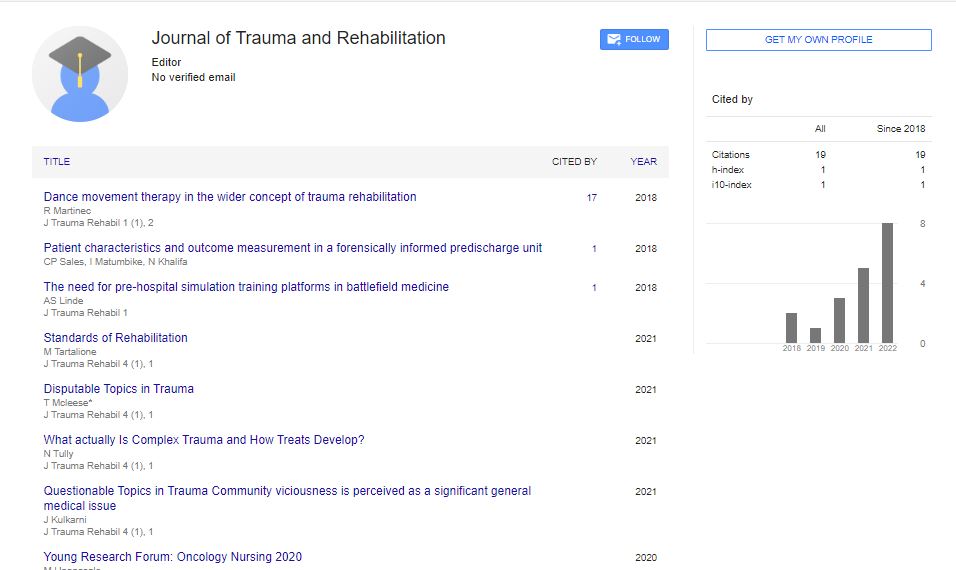Perspective, J Trauma Rehabil Vol: 6 Issue: 4
The Significance of Neurobiology in Traumatic Stress Symptomatology
Nicola Tierolf*
1Department of Intensive Care Medicine, Oslo University Hospital, Oslo, Norway
*Corresponding Author: Nicola Tierolf,
Department of Intensive Care Medicine,
Oslo University Hospital, Oslo, Norway
E-mail: nicotiero@ous-hf.no
Received date: 24 November, 2023, Manuscript No. JTR-24-127963;
Editor assigned date: 27 November, 2023, PreQC No. JTR-24-127963 (PQ);
Reviewed date: 11 December, 2023, QC No. JTR-24-127963;
Revised date: 18 December, 2023, Manuscript No. JTR-24-127963 (R);
Published date: 26 December, 2023, DOI: 10.4172/Jtr.1000147
Citation: Tierolf N (2023) The Significance of Neurobiology in Traumatic Stress Symptomatology. J Trauma Rehabil 6:4.
Description
Traumatic stress is a complex and pervasive phenomenon that manifests through a myriad of symptoms, affecting individuals on a physiological, emotional and cognitive level. Understanding the underlying neurobiological mechanisms involved in the development and expression of these symptoms is important for a comprehensive grasp of traumatic stress and its impact on the human psyche. The traumatic stress arises from exposure to excessively challenging situations an individual's ability to deal, leaving an indelible mark on the psychological well-being. The neurobiological response to such events involves complex interactions between the brain, nervous system and various neurotransmitters. An essential component in this complex ballet is the amygdala, a region deep within the brain responsible for processing emotions, particularly those associated with fear and threat. When faced with a traumatic event, the amygdala activates the body's stress response, causing the release of stress hormones such as cortisol and adrenaline. This cascade of neurological occurrences by preparing the individual to confront or flee from the perceived threat, a mechanism deeply ingrained in human evolution. However, in the context of traumatic stress, this heightened state of arousal can persist long after the threat has subsided, contributing to the development of symptoms such as hypervigilance, irritability and difficulty concentrating.
The complex connections between the amygdala and the prefrontal cortex further elucidates the neurobiological foundations of traumatic stress. The prefrontal cortex, responsible for higher-order cognitive functions such as decision-making and emotional regulation, plays a vital role in modulating the amygdala's response. In individuals experiencing traumatic stress, this regulatory function is often compromised, leading to an exaggerated and prolonged stress response. Moreover, the hippocampus, a region important for memory consolidation, is also implicated in the neurobiology of traumatic stress. Chronic exposure to stress hormones can impair the hippocampus, resulting in difficulties with memory and the formation of coherent narratives about the traumatic event. This phenomenon contributes to the fragmentation of memories, making it challenging for individuals to make sense of these experiences. The neurobiological impact of traumatic stress extends beyond the brain to the autonomic nervous system, which controls involuntary body functions such as heart rate, breathing and digestion.
Individuals with traumatic stress often exhibit dysregulation in the autonomic nervous system, leading to symptoms such as insomnia, gastrointestinal issues and an increased susceptibility to physical health problems. Neurotransmitters, the chemical messengers that facilitate communication between neurons, also play a pivotal role in the neurobiology of traumatic stress. Dysregulation of neurotransmitter systems, particularly those involving serotonin and dopamine, has been implicated in emotional disorders commonly associated with traumatic stress, such as depression and anxiety. The significance of understanding the neurobiology of traumatic stress lies in its potential to inform therapeutic interventions. Recognizing the complex traumatic stress is not merely a psychological phenomenon but deeply rooted in the complex functioning of the nervous system opening the avenues for customized treatments. Psychopharmacological interventions, such as medications that modulate neurotransmitter activity, can help alleviate some of the symptoms associated with traumatic stress.
Conclusion
Furthermore, neurobiologically informed psychotherapies, such as trauma-focused cognitive-behavioral therapy, aim to address the underlying neurobiological dysregulation by promoting the restructuring of maladaptive thought patterns and enhancing emotional regulation. These therapeutic approaches acknowledge the reciprocal relationship between psychological and neurobiological factors, providing a holistic framework for intervention. In, the significance of neurobiology in traumatic stress symptomatology lies in its ability to unravel the intricate web of physiological processes that underlie the manifestation of symptoms. A nuanced understanding of how the brain, nervous system and neurotransmitters respond to traumatic events provides a foundation for customized therapeutic interventions. By acknowledging the neurobiological dimensions of traumatic stress, people approach to a more comprehensive and compassionate approach to healing the wounds of trauma.
 Spanish
Spanish  Chinese
Chinese  Russian
Russian  German
German  French
French  Japanese
Japanese  Portuguese
Portuguese  Hindi
Hindi 